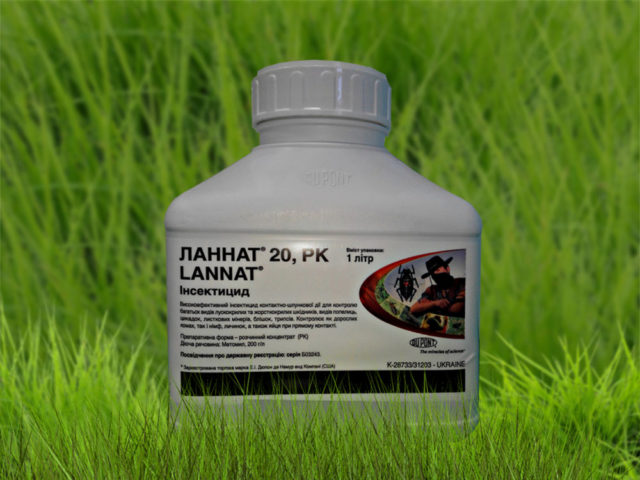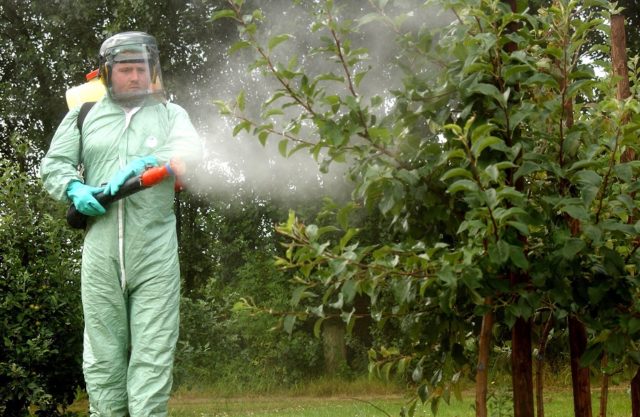Content
Pests are one of the main problems of garden and horticultural crops. When dealing with them, sometimes it is simply impossible to do without insecticides. And among the huge assortment, Lannat is at the forefront, since this drug belongs to the fast-acting. It does an excellent job of killing harmful insects at all stages of their development, killing more than half within the first hour after treatment. Instructions for the use of insecticide Lannat practically does not differ from this kind of drugs, while it is quite powerful and versatile in terms of use for both garden and garden plants.

Insecticide Lannat is a highly effective drug against sucking and gnawing pests
Description of the drug
Lannat is a contact insecticide belonging to the carbamate group. The drug itself has a wide spectrum of action and, if it comes into direct contact with insects, destroys adults, nymphs, larvae, and also has a detrimental effect on laid eggs. Due to its translaminar action, it quickly penetrates into the leaf plate, where it creates a destructive concentration for sucking pests and affects them even on the underside of the leaf.
Composition
The main active ingredient of Lannat insecticide is methomil, which, when it gets on a pest, penetrates into its body. Thus, with direct contact, within a quarter of an hour after spraying the plant, the active substance infects up to 40% of the insects on it.
Varieties and forms of release
Lannat is available as a wettable white crystalline powder or a 20% soluble concentrate with a mild sulphurous odor.
In the form of a powder, the drug can be purchased in a foil bag weighing 200 g and 1 kg. In liquid form, the insecticide is released in cans of 1 and 5 liters.
How does it affect pests
The active substance methomyl contained in the insecticide is capable of blocking the hydrolytic enzyme acetylcholinesterase in the synapse of insects at the cellular level, thereby paralyzing them.
Signs indicating that the drug has been hit by pests are manifested first in hyperactivity and tremor of the limbs, after which paralysis of the body occurs and the insect dies directly.
The substance begins to act within 15 minutes after treatment, showing the destruction of up to 40% of pests. After 1 hour, damage to 70% of insects can be observed, and in 4-6 hours, about 90% die.
The drug itself is used to combat more than 140 types of pests. Lannat shows high efficiency against the apple and oriental moth, grape, grape and biennial leafworm, winter moth, white butterfly. Also, the insecticide does an excellent job of killing aphids, whiteflies, leafhoppers and thrips.
The drug is effective regardless of weather conditions. It retains its effect both at temperatures lowered to + 5 ° С and up to + 40 ° С.
The most favorable time for processing is the period of laying the first eggs. Further, spraying is performed already when the larvae appear.
Consumption rates
The consumption rates of the drug are different depending on the treated plant and on what pests need to be destroyed, they are presented in the table:
Culture | Application rate l (kg) / ha | Application rate g / l | Harmful object |
Tomatoes (open ground) | 0,8-1,2 | 0,7-1,1 | Complex scoop, thrips, aphids |
White cabbage | 0,8-1,2 | 0,8-1,2 | Cabbage aphids, whiteworms, scoops, cabbage moth, thrips, cruciferous midges |
Bow (except for bow on a feather) | 0,8-1,2 | 0,7-1,1 | Onion fly, thrips |
Apple tree | 1,8-2,8 | 1,3-2,2 | Apple moth, apple sawflies, leaf rollers, leaf-eating caterpillars, aphids |
Grapes | 1-1,2 | 1,1-1,3 | All kinds of leaf rollers |
The concentration calibration method in the instructions for use of Lannat for 10 l of water is 12 ml.
Instructions for use of the drug Lannat
Lannat insecticide should be used only in the indicated dosages and in compliance with all safety measures. Spraying plants with a working solution must be carried out evenly, and its amount must be sufficient to cover the entire leaf surface.

Due to the high toxicity of Lannat, they must be treated early in the morning or late in the evening.
Preparation of the solution
Regardless of the type of insecticide Lannat as a powder or soluble concentrate, the working solution is diluted, strictly following the instructions for use immediately before starting treatment. To do this, the required volume of clean water is first poured into the container or sprayer tank, then the drug is added in small portions, mixing thoroughly. If there are no means of mechanization, the preparation of the working solution of the insecticide is prohibited.
When using a liquid soluble concentrate, it must be thoroughly shaken before pouring into water.
It is required to use the working solution on the day of preparation, since it cannot be stored in finished form. At the end of the treatment, the container (sprayer) is thoroughly washed.
Processing rules
Direct contact of the insecticide with pests is the most effective for their destruction, therefore Lannat is used precisely by spraying. The rules for the processing of horticultural and horticultural crops themselves are almost identical, with the exception of the waiting time and the amount of re-use.
Vegetable crops
The processing of vegetable crops with Lannat is carried out by the spraying method with the maximum capture of the entire leaf surface of the plants. It can be performed throughout the growing season. The deadline for processing is at least 3 weeks before harvest.
Melons crops
The treatment of melons and gourds with an insecticide is also carried out by spraying. This procedure is performed in calm and non-sunny weather. In this case, it is necessary to minimize the ingress of the drug on the fruits themselves, spraying only the tops. Also, do not spray the insecticide on the soil.
Fruit and berry crops
For fruit and berry crops, spraying is carried out at the rate of 600-1200 l / ha. Processing is carried out in clear weather at a temperature of at least + 5 ° C. It is required to spray the working fluid evenly over the entire leaf surface, including tree trunks when processing apple trees.
Garden flowers and ornamental shrubs
The processing of garden flowers and ornamental shrubs with Lannat is carried out in the period before bud break, as this helps to protect the plants from the larvae of harmful insects that have not yet hatched.
Spraying is best done in the morning in calm weather. First, the top of the shrubs is processed, then the crown and branches, and lastly the trunk. In this case, contact with the drug on the ground should be avoided.
Rules and frequency of processing
Insecticide Lannat is required to be used for prophylaxis exclusively in capital proportions during the laying of eggs by insects. In this case, re-spraying, if necessary, can be carried out only after 1-2 weeks.
The multiplicity of processing for peas and onions is no more than 2, for cabbage - 1, but on tomatoes in the instructions for use of Lannat, it can be used up to 3 times per season. The interval between spraying should not be less than 7 days. The waiting period for onions, cabbage, peas is 15 days, and for tomatoes - 5 days.
For an apple tree, the waiting period is 7 days, for grapes - 14. The number of treatments for the entire period is 3 times.

In order to avoid harm to bees, processing is carried out at a wind speed of 1-2 m / s and at a distance of 4-5 km from apiaries.
Compatibility with other drugs
To improve the strength of the insecticide and its effect, Lannat can be mixed with pesticides based on benomyl, cineb, sulfur, folpet, fosmet, dimethoate and maltion.
It is strictly forbidden to mix it with lime-sulfur and highly alkaline substances, as well as iron and Bordeaux liquid.
Pros and cons of using
Insecticide Lannat has an undeniable number of advantages:
- the drug has a translaminar effect, which allows it to quickly penetrate both the leaf plates of plants and the pests themselves;
- is a broad-spectrum insecticide that effectively controls more than 140 types of pests;
- affects harmful insects at any stage of their development, from eggs to adults;
- the insecticide is allowed for re-use 2 to 4 times per season;
- spraying can be carried out 3 weeks before harvest;
- retains its effect equally in cool and hot weather;
- does not wash out even if it rains within 2 hours after treatment;
- suitable for combined use with pesticides;
- decomposes rather quickly in the environment and has a low percentage of accumulation in fruits;
- quick recovery of beneficial insects.
But, like any chemical drug, Lannat has the following disadvantages:
- 2 degree of danger for warm-blooded animals;
- the use of an insecticide near water bodies and apiaries is prohibited;
- the drug is exclusively contact and does not have a systemic effect, therefore it does not apply to new points of plant growth.
Precautions
Since the insecticide Lannat belongs to the 2nd class of danger for humans and animals, it is imperative to observe all precautions when using it. Spraying of plants is carried out in protective equipment, gloves and with a respirator.
After processing, a safe exit to mechanized work is allowed no earlier than 4 days, for manual work - 10 days.
Storage rules
Store the Lannat insecticide in a dry and closed room from sunlight with a temperature of at least 10 ° C and no higher than 40 ° C. It is also important that the product is kept away from sources of heat, fire, medicine and food. Was out of reach of children.
Shelf life - 2 years from the date of manufacture.
Conclusion
Instructions for the use of insecticide Lannat has its own nuances, the observance of which guarantees high-quality treatment of garden and vegetable crops from harmful insects. And to obtain high efficiency of this drug, it should be used at the recommended consumption rates, as well as to ensure uniform coverage of plants during spraying.








